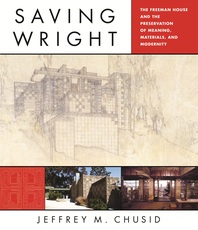
Saving Wright
The Freeman House and the Preservation of Meaning, Materials, and Modernity
23 December 2011
Description
Winner of the Society of Architectural Historians' 2014 Antoinette Forrester Downing Book Award; Winner of the University of Mary Washington Center for Historic Preservation's 2012 Historic Preservation Book Award
"Dear Mrs. Freeman: I am glad to know that you are still happily 'at home.' Sincerely, Frank Lloyd Wright."
Winner of The University of Mary Washington Center for Historic Preservation's 2012 Historic Preservation Book Prize, this book is a case study on the preservation of an important work of modern architecture. The story of the Freeman House, and of the attempt to save it, entails almost all of the provocative issues that make historic preservation as a field so fascinating, technologically and theoretically complex, and politically charged.
Saving Wright chronicles the ongoing struggle to save Wright’s Freeman House in the Hollywood Hills, the setting for fascinating people and events but deeply flawed from the time it was built ninety-five years ago. The Freeman House was an experiment born out of Frank Lloyd Wright’s polemical vision of a new kind of architecture for the middle class, for modern America, and, in particular, for the Los Angeles foothills. Its design and construction were difficult, thus, along with many poor decisions, planting within a beautiful work of architecture the seeds of its own destruction.
Jeffrey M. Chusid, who lived in the house and studied it while Harriet Freeman was still alive and residing there and, later, after she gave it to the School of Architecture at the University of Southern California, examines the experimental “textile-block” construction system, the power of Wright’s architecture, the interaction of people and place, and the concepts and challenges of historic preservation—why and how we do it. The Freeman House is a valuable case study because it serves as a test of established preservation procedures and protocols, of building forensics and conservation techniques, and of the meaning of a historic site to overlapping and not necessarily compatible communities.
Saving Wright also received an honorable mention for the 2012 Lee Nelson Book Award from the Association for Preservation Technology, Intl. (APT).
Reviews
"This extraordinarily engaging book goes to the heart of key issues related to the preservation not only of Frank Lloyd Wright’s architecture but also of all modernist buildings whose materials and methods were experimental in their time. . . . This book wholly recovers historical and technical realities and, just as importantly, frames them narratively in such a way that the reader sees this case study as representative of field-wide concerns." — Buildings & Landscapes: Journal of the Vernacular Architecture Forum
"This well-written and informative book shares [Chusid’s] close-up view of a fascinating case study and discusses philosophical issues and practical problems that we encounter with many twentieth-century structures. . . . [A] valuable addition to the libraries of admirers of Frank Lloyd Wright and preservation professionals involved with twentieth-century structures." — APT Bulletin: Journal of Preservation Technology
"[A] wonderful new book…. [T]his is much more than another book about another Wright house, its clients and it design. The book is a detailed case study in historic preservation and the myriad challenges entailed in the task…. [C]ompelling reading for scholars and aficionados of Wright’s work." — The Journal Times Online
"The book’s subject is the perfect laboratory for considering such issues as the advisability of removing the work of later architects to expose the original building, and whether to retain failing structural materials in an earthquake zone or to re-engineer some of the parts in order to preserve the whole. . . . [T]he thoughtful text, accompanied by extensive, detailed photographs of the original construction and later preservation, will help guide readers in making these decisions." — Style 1900: Antiques & Interiors


